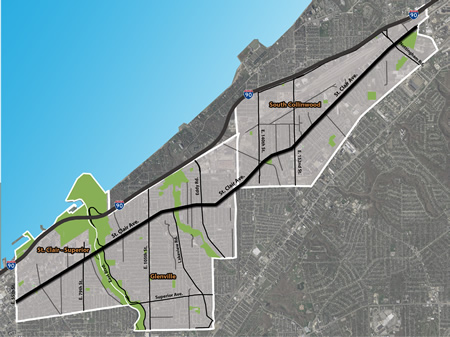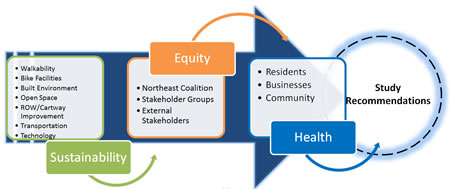ABOUT

St. Clair Ave. is one of the most traveled corridors in the City of Cleveland. It is a major arterial that courses through three neighborhoods, three CDC service areas, four council wards, and two county districts. St. Clair Avenue directly serves over 46, 000 residents in northeast Cleveland. The corridor supports a mixture of uses that range from retail to industrial and residential to institutional. Launching a study of this magnitude is so critical because there are currently several planning related initiatives going on the City of Cleveland that could provide additional resources and spur broader collaborative development.
PLAN ELEMENTS
The St. Clair Avenue Corridor Study will focus on the seven plan elements of Walkability, Bike Facilities, the Built Environment, Parks/Open Space, Public Transportation, R-O-W/Cartway Improvement, and Technology. Listed below are just some of the features that can be improved to create a corridor that is Healthy, Equitable, and Sustainable.
 Parking, Meters, Lane Widths, Street Repair Parking, Meters, Lane Widths, Street Repair Benches, Crosswalks, Lighting, Walking Routes Benches, Crosswalks, Lighting, Walking Routes Bike Lanes, Bike Racks, Signage, Safety, Trails Bike Lanes, Bike Racks, Signage, Safety, Trails Rehab, Land Use, Demolition, Preservation Rehab, Land Use, Demolition, Preservation Open Spaces, Placemaking, Green Infrastructure Open Spaces, Placemaking, Green Infrastructure BRT, Bus shelters, Service, Signage, Connections BRT, Bus shelters, Service, Signage, Connections Fiber Optic Technology Fiber Optic Technology
PROCESS
The St. Clair Avenue Corridor Study will focus on Walkability, Bike Facilities, the Built Environment, Open Space, R-O-W/Cartway Improvement, Public Transportation, and Technology in the area between E. 55th St and E. 185th by
- Analyzing the state of the community and current land-use patterns.
- Identifying opportunities for bike, pedestrian, greenway, and technology connections.
- Identifying potential sites for economic development through land assembly, building rehabilitation, and targeted demolition.
- Identifying options for utilities, R-O-W improvement, and way finding.
- Providing implementation recommendations.

|

